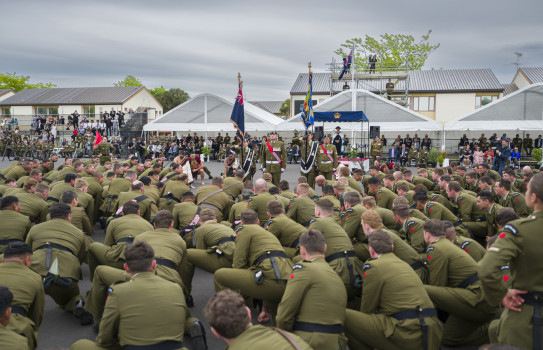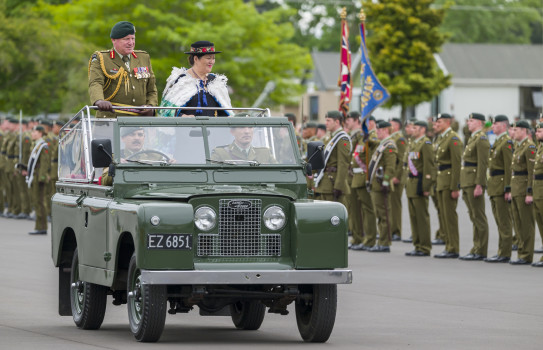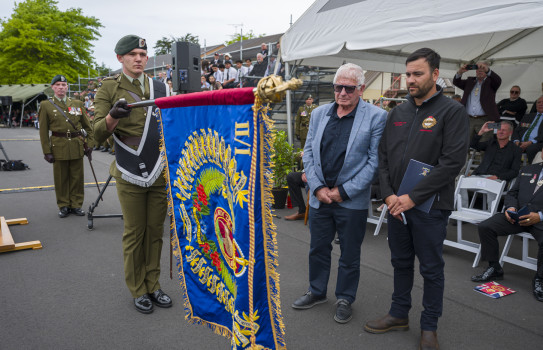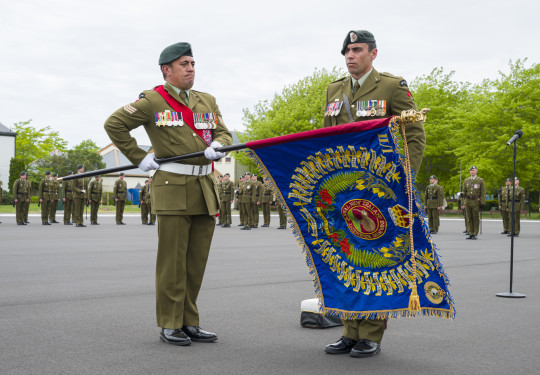King Charles proud of link to NZ Army as battalion’s new Colours consecrated at Burnham parade
In a significant event for this country’s military, the first Colours have been consecrated and presented to a unit of the New Zealand Defence Force (NZDF) during the reign of King Charles III.
01 November, 2024
The new Colours (ceremonial flags) were presented to 2nd/1st Battalion, Royal New Zealand Infantry Regiment’s (2/1 RNZIR) by Her Excellency, The Rt Hon Dame Cindy Kiro, GNZM, QSO, Governor-General of New Zealand, on behalf His Majesty at Burnham Military Camp yesterday.
In his message to the battalion, His Majesty said that while he was unable to be at the parade in person it gave him a great sense of pride that 2/1 RNZIR had received the Colours in his name.
Your country and your regiment’s history is sewn into the very fabric of these Colours. They recall the courage and selfless commitment on the battlefield of soldiers who, like yourselves, were drawn from every part of New Zealand.
“May these Colours serve as a constant inspiration to you and to those who come after you.
“I am proud to give them into your safekeeping in the knowledge that you will continue to uphold the standards and spirit of your country and the Royal New Zealand Infantry Regiment.”
The new King’s and Regimental Colours are the first to be presented to the NZDF during His Majesty’s’ reign and the first Colours be presented to any New Zealand Army unit since 1997.
2/1 RNZIR’ previous Colours, which were presented during the reign of Queen Elizabeth II in 1980, were trooped for the last time and the new King’s Colour and Regimental Colour were consecrated at a parade attended by more than 500 people.


2/1 RNZIR Commanding Officer, Lieutenant Colonel Sam Smith, says the consecration of the new Colours is an historic event for the New Zealand Army.
“An infantry battalion is an enduring entity. This is through the reverence of our war memory, but primarily it is through our people.
“The officers and soldiers of 2/1 RNZIR, as descendants of several proud regiments, accept the responsibility of honouring and holding the legacy of their service and sacrifice,” Lieutenant Colonel Smith said.
Eight new battle honours are emblazoned on the new Regimental Colour, of which six have never been emblazoned onto any other Infantry Colour in the New Zealand Army.
They are HILL 60 (ANZAC) and DELVILLE WOOD, which are unique to the New Zealand Maori Contingent and the New Zealand Maori (Pioneer) Battalion respectively; OLYMPUS PASS and MONASTRY HILL, which are unique to or uniquely chosen for emblazonment by 28 (Maori) Battalion; and VEVE and SILLARO CROSSING, which are unique to or uniquely chose for emblazonment by 27 (Machine Gun) Battalion.
The two remaining battle honours, SARI BAIR and SOMME 1916, 18, are inherited from the New Zealand Maori Contingent and the New Zealand Rifle Brigade respectively.
“We acknowledge all who have served in our predecessor battalions as they take their rightful place in our shared history through the emblazonment of these new battle honours,” Lieutenant Colonel Smith said.

The last surviving members of 27 (Machine Gun) Battalion, 102 year-old Doug Reid and 28 (Maori) Battalion, 99 year-old Tā Robert ‘Bom’ Gillies were unable to attend the parade, but were represented by their whānau.
In a special dedication to both veterans the Regimental Colour was presented to their whānau on parade for inspection. It was the first time they were able to view the Colours and the newly emblazoned battle honours.
“I salute these two incredible veterans who fought to be here with us today to represent their comrades, but who unfortunately couldn’t make it down in person. It has been many years since these last surviving warriors and their mates fought in the passes of Greece, the dust of the deserts of North Africa and the mud and rain of Italy,” Lieutenant Colonel Smith said.
2/1 RNZIR Honorary Colonel Major General (Rtd) Evan Williams, ONZM, says the responsibility bestowed upon the unit is one they should be proud of.
“They have been entrusted with the legacy of those who went before – this will never be forgotten. For the generations that follow they will now have a better chance to understand the deeper history of the Army that they serve -- Ngāti Tūmatauenga,” Major General Williams said.
It is extremely important that New Zealand infantry soldiers know their roots, what the heritage and traditions are, and where they come from so they can understand what is expected of them now, and into the future. This is the purpose of the Colours.
Although Colours are no longer carried into battle, they continue to be paraded ceremonially to signify each battalions’ unique history, esprit de corps and identity. For Ngāti Tūmatauenga, the NZ Army, these traditions date back to the mid 1800s.
